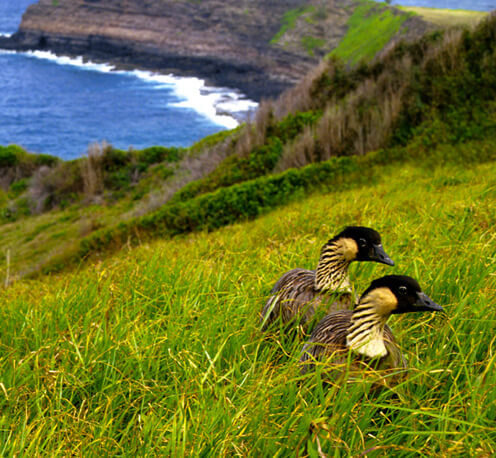Iconic, Endangered Hawaiian Bird Making Remarkable Comeback, Challenges Remain
Contact: Robert Johns, 202-234-7181 ext.210,
 |
Two Nēnē, or Hawaiian Geese, USFWS |
(Washington, D.C.,
The bird has also now expanded its range from the Big Island of Hawai‘i to Maui, Kaua‘i, and Moloka‘i. The recovery has been led by the U.S. Fish and Wildlife Service, U.S. Geological Survey, the National Park Service and the Hawai‘i Division of Forestry and Wildlife.
The five-pound, 25-inch long Nēnē –is designated as the state bird of Hawai‘i– and is thought to be descended from the Canada Goose and has evolved into its present-day form after thousands of years of isolation on the archipelago. It existed in substantial numbers in Hawai‘i until impacts from hunting, habitat loss, and a host of introduced predators, including black rats, Polynesian rats, Norway rats, dogs, cats, and the small Indian mongoose, took their toll.
Concern about the dwindling numbers of Nēnē prompted territorial fish and game biologist J. Donald Smith to launch a modest captive breeding program in 1949 using just two birds. That effort floundered until three more wild Nēnē were added to the captive population in 1960. The original problems of low fertility, limited hatching success, and low survivability diminished, and the bird’s population showed a steady escalation in the following decades.
In 1960, the first captive-raised Nēnē were released into the wild at Keauhou Sanctuary on the Island of Hawai‘i. The birds were originally tracked using radio telemetry, but this proved difficult over the island’s rough terrain. As a result, what little was known about recent movements of the recovering population was based on observations of banded birds and counts of birds made regularly along well known flight paths. However, in a three-year period from 2009-2011, 11 birds were fitted with 45-gram, solar powered satellite transmitters that have since provided invaluable information on feeding, roosting, and breeding sites, including data on over 10,500 locations visited by the birds.
Some of the data yielded from the transmitters has been surprising. Some birds have been turning up at remote, ancestral sites where once dense grass cover has since been replaced by fresh lava flows. It remains unclear why the Nēnē would leave the rich habitat of Hakalau Forest National Wildlife Refuge 50 miles away for an area dominated by lava.
In addition, the birds are exhibiting patterns of seasonal movement that have not been seen in about 100 years – travelling to lowland areas to breed and then to higher elevations during non-breeding periods.
“How these patterns of behavior have re-emerged after many years and many generations of Nēnē being captive bred, is indeed puzzling and something that we need to sort out if we are to create a viable, stable, long-term population of Nēnē in Hawai‘i,” said Dr. Steven Hess, of the U.S. Geological Survey’s Pacific Islands Ecosystems Research Center in Hawai‘i.
“This is the kind of good news story we want to see more of in Hawai‘i. For sure, we still have a long way to go before the Nēnē can be considered recovered and removed from the Endangered Species List, but the recurrence of these ancestral behaviors and the overall increase in the population is cause for optimism,” said George Wallace, Vice President for Oceans and islands at American Bird Conservancy.
Despite the successes, there are many challenges to the long-term recovery of Nēnē populations. The strength of wild Nēnē populations is due in significant part to predator control, and in the absence of predator control, it remains questionable whether many Nēnē populations will persist. Studies show that the bird has a relatively low tolerance for drought conditions, something that may occur more frequently with climate change. Because of development on the islands and the expansion of human activities, the Nēnē continues to experience high rates of predation by dogs, as well as exposure to the disease toxoplasmosis from feral or outdoor cats. On Kaua‘i, where populations have skyrocketed, safety officials are concerned about the increased chances of an airstrike with planes at the island’s airport that will likely result in significant numbers of birds being relocated to the Big Island.


















































